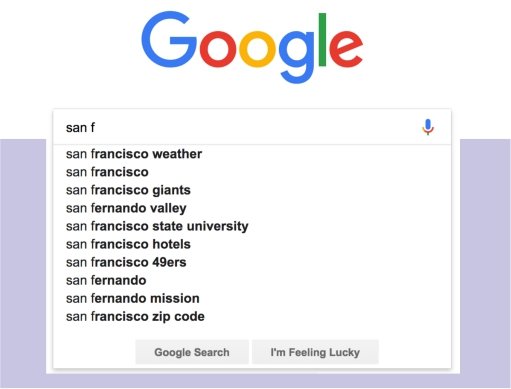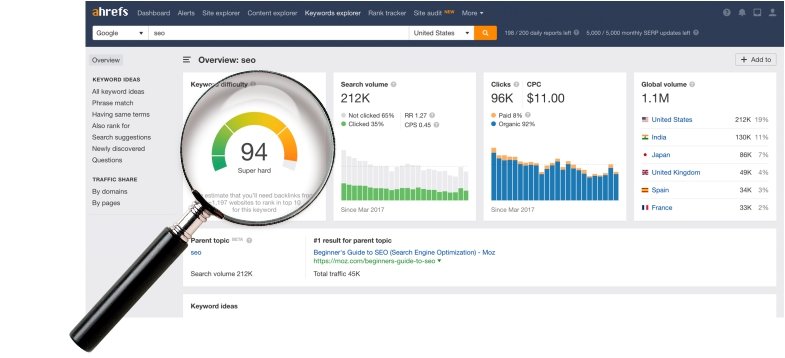What are long-tail keywords and how to find them?
Posted On July 22nd, 2024
Array

Long tail keywords are query phrases with a low search volume and degree of competition. Long tail phrases are also often lengthier in depth (3+ words) than the majority of keyword categories. They are often lengthier and much more descriptive than their head equivalents and hence have a greater conversion rate. Long-tail keywords are said to be simpler to search for and engage effectively.
For instance, the key phrase “meditation” is a ‘head’ keyword because it receives 211k monthly searches. While the keyword “can meditation make you smarter” is a long-tail keyword, and it acquires only 50 searches per month.
Long-tail keywords were indeed named because of their location on the query demand curve. However, a term does not have to receive fewer than ten searches per month to qualify as long-tail. Furthermore, no defined search traffic threshold defines a query as ‘long-tail.’ It is mostly determined by the ‘head’ keyword to which it is being compared. A significant error, though, would be to define lengthy keywords by their word count. The problem is that many one-word keywords receive less than 100 searches per month. There are also five-word (or more) keywords with tens of thousands of monthly searches.
When you enter a term into Keywords Explorer, we look at the top-ranked domain for that keyword and determine whether there is a more common search query for which this page is ranking. Filtering long-tail keywords from websites is a time-consuming task. You’ll also need to employ an SEO tool, like Keywords Explorer, to examine the search quantities and KD of your term suggestions.
What makes the use of Long tail keywords unique?

Long-tail keywords hold unique advantages compared to their shorter, broader counterparts (head keywords). Here’s what makes them special:
- High Specificity: Long-tail keywords are more specific and detailed, targeting a narrower range of searches. Imagine searching for “pizza” (head term) versus “best deep dish pizza near me with gluten-free crust” (long-tail term).
- Lower Competition: Due to their specificity, long-tail keywords typically have lower competition. This means you’re more likely to rank higher in search results for these terms.
- Higher Conversion Rates: Searchers using long-tail keywords are often closer to making a purchase decision. They know exactly what they want, and their search reflects that intent. This can lead to higher conversion rates (e.g., website visitors turning into buyers).
- Less Seasonality: Unlike head terms with seasonal trends (e.g., “beach vacation” in summer), long-tail keywords tend to be more consistent in search volume throughout the year.
Long-tail keywords are on average less competitive
Assume you’ve recently created a cryptocurrency blog. There are several prominent keywords with significant search volumes that have the potential to deliver massive amounts of viewers to your blog, such keywords are appealing to target. All of the keywords listed above get a significant Keyword Difficulty (KD) score. This means that getting to the top page of Google for any one of them will be extremely difficult. That achievement will be nearly difficult if your webpage is spanking new. This indicates that even a brand-new website has the possibility to rank in the list of top 10 search results and receive several traffic from such terms.
Long-tail keywords are easier to address
Let’s continue to compare the two groups of terms. Like how one must answer a simple question to ‘How to Buy Bitcoin’.
– However, the top-ranking webpage for that search term is really 3,400 words long.
– While the top-ranking website for ‘how to pay out enormous quantities of bitcoin’, on the other hand, is just 1,000 words in length.
The trouble is, the more comprehensive the search query, the more information you’ll need to offer when responding to it. However, if the search question is precise, you can frequently answer it quickly while still satisfying the searchers. In other words, developing stuff for long-tail keywords takes less effort.
Aside from that, you might hunt for a group of similar long-tail search terms and approach them with pages that change just slightly. The very same site builder tool would most likely fit counselors as well as teachers or performers. This implies you can target all of these distinct queries with webpages that have 80% of the information in common, but the remaining 20% is personalized to each profile page. In other words, one can simply develop a dozen pages to meet comparable long-tail inquiries on a similar day.
There are a lot of Long-tail keywords to explore
Yes, each long-tail term will not generate torrents of visitors to your website. However, when you resolve a greater number of concerns, the search volume will ultimately build up to something significant. And, because there are so many long-tail keywords in almost every area, you’re unlikely to encounter them. Long-tail keywords are not all the same. Some are distinct search queries, while others are simply a less common version of a more prevalent search term. The former is referred to as ‘topical long-tail keywords, while the latter is referred to as ‘supporting long-tail keywords.
Let us demonstrate with an example- ‘Best nutritious snacks for dogs’ is clearly a long-tail keyword, with just 100 searches per month.
However, there are a few additional search terms that signify the same thing but have a significantly higher search volume. If you research each of them on Google, you’ll see that the identical pages rank first for each one of these keywords. Google is intelligent enough to recognize different individuals’ words and their queries differently even while looking for the same subject. As a result, it evaluates the very same collection of pages for each keyword variant.
This implies that if your website begins to rank for a big search query, such as ‘healthy dog treats’ (6.8k searches), it will also rank for all of the query’s long-tail variations. As a result, you don’t need to construct multiple variations for every long-tail variation. You should instead address them all with a separate page.
How should one use Long tail keywords?
Here are two alternatives on how one must use search queries when it comes to incorporating long tail keywords into the content:-
Use Google Autosuggest

Some SEO professionals recommend using Google Autosuggest to find long-tail keywords by inputting your target term followed by various characters from the alphabet. Google Autosuggest is a functionality that allows you to quickly access popular search terms. So, if we look at the search volumes of the phrases, we can see that the majority of them have a reasonable number of searches.
In other words, rather than the sought-after long-tails, Google Autosuggest is significantly more likely to provide users with very popular search phrases. The same is true for online applications that scan Autosuggest to produce keyword ideas, such as Answer The Public and Soovle. Many of their keyword suggestions will turn out to be quite popular and competitive.
Use Ahref’s Keyword Explorer

Ahref’s Keyword Explorer does not need any time-consuming physical labor. Simply search for any phrase that describes your specialty in Keywords Explorer and use the keyword search filter to view thousands of long-tail keywords instantaneously. If your website is brand new and has little ‘authority’, it is recommended to use the KD filter to locate the least competitive keywords. Make use of the ‘Questions’ button as well, as it frequently yields some interesting long-tail search searches.
The Ahrefs Site Explorer will show you which long-tail keywords are ranking for Simply enter a competitor’s website into Site Explorer and navigate to the Inbound keywords report, checking out which long-tail keywords would be driving traffic to their site. Repeat this process with 5-10 of your rivals’ websites, and you’ll have enough long-tail keyword suggestions to keep you occupied for months.
When individuals visit Google and are unable to obtain a satisfactory response to their query, they post it on sites such as Quora and Reddit. A short search on Keywords Explorer uncovered that ‘marketing manipulation’ is a long-tail term with a low KD score. The advantage of this strategy is that such discussion threads could contain some interesting conversations, which may be valuable when writing material on that topic.
The disadvantage is that extracting long-tail keywords from websites is a time-consuming procedure. You’ll also need to apply an SEO tool, such as Keywords Explorer, to examine the search volumes and KD of your term suggestions.
Benefits of Long-Tail Keywords
The digital landscape has evolved rapidly over the last decade, and so have the strategies businesses use to gain online visibility. Among the various SEO practices, the use of long-tail keywords stands out as one of the most effective methods to attract organic traffic and convert potential leads. Here are the benefits of leveraging these longer and more specific keyword phrases:
- Lower Competition: Unlike short, generic keywords, long-tail keywords face less competition. This means that targeting them provides an opportunity to rank higher in search engine results with relatively less effort. For instance, ranking for “shoes” is far more challenging than for “women’s red running shoes.”
- Higher Conversion Rates: People using long-tail keywords are often further along in the buying cycle. A user searching for “best wireless earbuds for running” probably has a clear intention to purchase, as opposed to someone just searching “earbuds.” This specificity makes long-tail keywords goldmines for conversion.
- Cost-Effective for PPC: If you’re running pay-per-click (PPC) campaigns, targeting long-tail keywords often results in lower costs-per-click (CPC). Since they’re less competitive, you won’t have to bid as much to secure top ad placements.
- Better Content Opportunities: When you focus on long-tail keywords, you have the chance to create content that specifically addresses niche questions or concerns. This paves the way for content that deeply resonates with a particular audience segment, establishing trust and authority.
- Enhances Voice Search Strategy: With the rise of voice-activated assistants like Siri, Alexa, and Google Assistant, users are making more conversational queries. Long-tail keywords often align with the natural language patterns used in voice searches.
- Richer User Insights: The specificity of long-tail keywords can provide businesses with detailed insights into the user’s intent, pain points, preferences, and demographics. This knowledge can further refine marketing strategies.
- Aids in Building Topic Clusters: Topic clusters are becoming a fundamental SEO strategy. By identifying and creating content around core topics and their related long-tail queries, you can build a cohesive, interconnected web of content that search engines love.
In conclusion, while the allure of ranking for broad, high-volume keywords is tempting, the real value for businesses often lies in targeting the more precise long-tail phrases. Not only do they offer a path to SEO success with lower competition, but they also connect businesses to users with clear intent, yielding better conversions and a deeper understanding of the target audience.
Related Posts

Google Ads: Ultimate Guide to Google Ads Success in 2025
Posted on December 11th, 2025
Have you ever wondered how businesses seem to appear magically at the top of your Google search results? The answer is almost always Google Ads. As the dominant force in online advertising, Google...
Read More →
How to Create Instagram Reels Using Meta AI: A Complete Beginner-Friendly Guide
Posted on November 30th, 2025
Instagram keeps growing every single day, and almost everyone wants to create Instagram Reels because they’re fun, quick, and perfect for reaching a bigger audience. However, a lot of...
Read More →
How to Add a Free AI Assistant to Your Website: 3 Easy Methods
Posted on November 20th, 2025
Want to add a free AI assistant to your website without spending a single penny? You’re in the right place! Adding an AI assistant can transform how visitors interact...
Read More →
What Is Content Marketing? Best Content Marketing Strategies & Why It Still Works in Today’s Digital World
Posted on November 17th, 2025
Content, marketing, strategies, and digital growth shape the way modern brands succeed today. Because online behavior keeps evolving rapidly, businesses rely heavily on strong digital content marketing strategies to...
Read More →© All Copyright Reserved japjitravel.com
Leave a Comment :